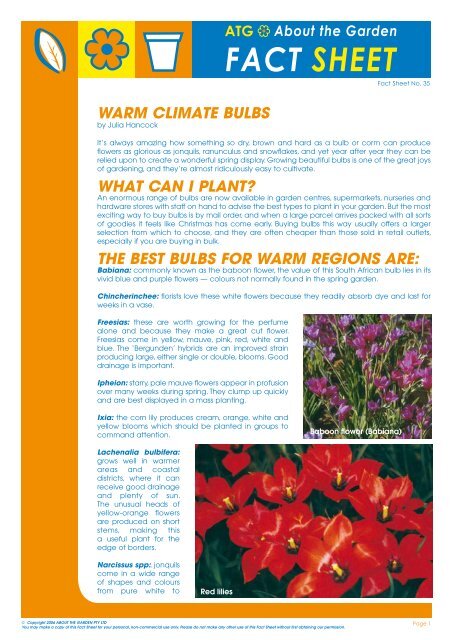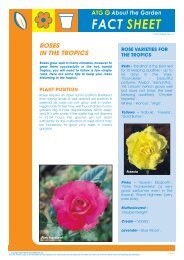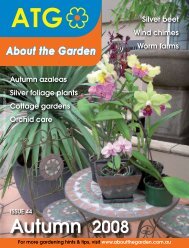FACT SHEET - About The Garden Magazine
FACT SHEET - About The Garden Magazine
FACT SHEET - About The Garden Magazine
Create successful ePaper yourself
Turn your PDF publications into a flip-book with our unique Google optimized e-Paper software.
ATG<br />
ATG<br />
WARM CLIMATE BULBS<br />
by Julia Hancock<br />
<strong>About</strong> the <strong>Garden</strong><br />
<strong>About</strong> the <strong>Garden</strong><br />
<strong>FACT</strong> <strong>SHEET</strong><br />
© Copyright 2006 ABOUT THE GARDEN PTY LTD<br />
You may make a copy of this Fact Sheet for your personal, non-commercial use only. Please do not make any other use of this Fact Sheet without first obtaining our permission.<br />
Fact Sheet No. 35<br />
It’s always amazing how something so dry, brown and hard as a bulb or corm can produce<br />
flowers as glorious as jonquils, ranunculus and snowflakes, and yet year after year they can be<br />
relied upon to create a wonderful spring display. Growing beautiful bulbs is one of the great joys<br />
of gardening, and they’re almost ridiculously easy to cultivate.<br />
WHAT CAN I PLANT?<br />
An enormous range of bulbs are now available in garden centres, supermarkets, nurseries and<br />
hardware stores with staff on hand to advise the best types to plant in your garden. But the most<br />
exciting way to buy bulbs is by mail order, and when a large parcel arrives packed with all sorts<br />
of goodies it feels like Christmas has come early. Buying bulbs this way usually offers a larger<br />
selection from which to choose, and they are often cheaper than those sold in retail outlets,<br />
especially if you are buying in bulk.<br />
THE BEST BULBS FOR WARM REGIONS ARE:<br />
Babiana: commonly known as the baboon flower, the value of this South African bulb lies in its<br />
vivid blue and purple flowers — colours not normally found in the spring garden.<br />
Chincherinchee: florists love these white flowers because they readily absorb dye and last for<br />
weeks in a vase.<br />
Freesias: these are worth growing for the perfume<br />
alone and because they make a great cut flower.<br />
Freesias come in yellow, mauve, pink, red, white and<br />
blue. <strong>The</strong> ‘Bergunden’ hybrids are an improved strain<br />
producing large, either single or double, blooms. Good<br />
drainage is important.<br />
Ipheion: starry, pale mauve flowers appear in profusion<br />
over many weeks during spring. <strong>The</strong>y clump up quickly<br />
and are best displayed in a mass planting.<br />
Ixia: the corn lily produces cream, orange, white and<br />
yellow blooms which should be planted in groups to<br />
command attention.<br />
Lachenalia bulbifera:<br />
grows well in warmer<br />
areas and coastal<br />
districts, where it can<br />
receive good drainage<br />
and plenty of sun.<br />
<strong>The</strong> unusual heads of<br />
yellow-orange flowers<br />
are produced on short<br />
stems, making this<br />
a useful plant for the<br />
edge of borders.<br />
Narcissus spp:. jonquils<br />
come in a wide range<br />
of shapes and colours<br />
from pure white to<br />
Red lilies<br />
Baboon flower (Babiana)<br />
Page 1
ATG<br />
ATG<br />
<strong>About</strong> the <strong>Garden</strong><br />
<strong>About</strong> the <strong>Garden</strong><br />
<strong>FACT</strong> <strong>SHEET</strong><br />
apricot, often with contrasting cups. <strong>The</strong> multi-flowered ‘Erlicheer’ is one<br />
of the best with large heads of creamy, perfumed, double blooms on long<br />
stems. An excellent cut flower.<br />
Rununculus: if strong colours are what you are after, then ranunculus is<br />
the bulb, or more correctly, corm, for you. It comes in velvety royal purple,<br />
saffron yellow, pure white, shocking pink, flame orange and strawberry<br />
red.<br />
Snowflakes: often confused with the English snowdrop,<br />
these dainty, white bell-shaped flowers are distinguished<br />
by the green spot near the tip of each petal.<br />
Sparaxis: the common name harlequin flower refers<br />
to its wide range of single and multi-coloured flowers.<br />
Sprekelia: the pure red Jacobinian lily should be more<br />
widely grown because it is spectacular and can be<br />
left undisturbed for several years. Protect from hot sun.<br />
Tritonia: similar to freesias and sparaxis in appearance,<br />
tritonias are late season bloomers which are useful for<br />
filling the gap between spring and summer.<br />
HOW TO PLANT AND<br />
MAINTAIN YOUR BULBS<br />
Bulbs prefer well-drained, slightly acid soil<br />
which has been prepared in advance with<br />
the addition of organic compost or wellrotted<br />
cow manure. Clay soil should be<br />
broken up with gypsum before planting. As<br />
a general rule, bulbs should be planted to a<br />
depth twice that of their size. Make sure the<br />
narrowest end, or neck, is at the top. Backfill<br />
the planting hole gently to avoid damaging<br />
the growing tip.<br />
<strong>Garden</strong>ers with the luxury of space should<br />
plant bulbs in large drifts, clumps and islands<br />
for maximum impact. Many, such as jonquils<br />
and snowflakes can be left to naturalise and<br />
multiply on their own for a number of years.<br />
Hot tip: If your garden is small, plant your<br />
bulbs into a large plastic pot and sink it into<br />
the ground. When your bulbs have finished<br />
flowering simply lift the pot out and store it<br />
in a cool dry place until next year. This is also<br />
a good idea if your garden is subjected to<br />
excessive summer heat.<br />
Lower growing bulbs such as jonquils,<br />
ipheion and rancunclus make excellent pot<br />
plants for sunny balconies and patios. Use<br />
a specially formulated bulb planting mix in<br />
a pot with generous drainage holes. For a<br />
© Copyright 2006 ABOUT THE GARDEN PTY LTD<br />
You may make a copy of this Fact Sheet for your personal, non-commercial use only. Please do not make any other use of this Fact Sheet without first obtaining our permission.<br />
Fact Sheet No. 35<br />
Autumn crocus (Zephranthes)<br />
Page 2
ATG<br />
ATG<br />
<strong>About</strong> the <strong>Garden</strong><br />
<strong>About</strong> the <strong>Garden</strong><br />
<strong>FACT</strong> <strong>SHEET</strong><br />
© Copyright 2006 ABOUT THE GARDEN PTY LTD<br />
You may make a copy of this Fact Sheet for your personal, non-commercial use only. Please do not make any other use of this Fact Sheet without first obtaining our permission.<br />
Fact Sheet No. 35<br />
dense display plant bulbs in two layers approximately 10cm apart. Keep moist but not wet.<br />
Bulbs store their own food for use during the current season’s flowering and should therefore be fed<br />
with a soluble fertiliser when the flowers have finished but before the foliage has died back. For this<br />
reason it is essential to resist the temptation to cut off straggly foliage until it is completely dead.<br />
JULIE LAKE’S 10 BEST BULBS<br />
Bulb plants are so easy to grow and give<br />
Star flowers (Ipheion)<br />
Hippeastrum (Amaryllis)<br />
Jacobian lily (Sprekelia)<br />
so much glorious reward in the garden for<br />
so little effort. Wondering which bulbs to<br />
choose? Here’s my tip for the 10 best bulbs<br />
for warm climates — you can even grow<br />
them during the cool season in tropical<br />
highland areas, provided they have really<br />
good drainage.<br />
• Amaryllis: <strong>The</strong> ever-popular Belladonna<br />
Lily whose rose pink flowers appear for a<br />
long time from summer to autumn.<br />
• Babiana: So pretty and easy to grow for<br />
a spring show. Deep purple is the bestknown<br />
colour but others are available.<br />
• Cyrtanthus: Known as Ifafa Lily, this dainty<br />
little flower in shades of pink is good for<br />
planting under trees.<br />
• Freesia: A must for every garden, not only<br />
because of the wide range of colours<br />
and forms, but because of its heavenly<br />
smell which sweetens the air in spring.<br />
• Hymenocallis: Evergreen, so it always<br />
looks good in the garden, the spidery<br />
white flowers add a cool touch in spring<br />
and summer.<br />
• Ixia: A good plant for rock gardens and<br />
dry spots; very dainty, in several colours.<br />
Flowers in late winter and spring.<br />
• Lachenalia: Red, yellow or orange bells<br />
brighten the garden in winter and spring.<br />
• Sprekelia: <strong>The</strong> bright red flowers with<br />
golden centres add a warm touch to late<br />
winter and early spring gardens.<br />
• Watsonia: A very good warm climate<br />
bulb for spring and summer, in all sorts of<br />
lovely colours.<br />
• Zephyranthes: Sometimes called Autumn<br />
Crocus or Storm Flower because it usually<br />
flowers after rain. Despite the name it<br />
can appear sporadically from summer<br />
through autumn.<br />
Page 3





